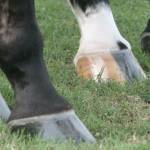Rings and Ridges: What Horse Hooves Reveal

Just as coat condition serves as an indication of health status in horses—sheen and dapples suggest vitality, whereas dull, rough, or half-shed coats imply unthriftiness or disease—changes in hooves may provide clues to a horse’s historical well-being.
The hoof wall is subject to any number of imperfections, and it is commonplace for hooves to show shallow or deep cracks, chipped toes, or flares, especially if they are not under the scheduled care of a professional farrier. These flaws are obvious. More subtle changes in the hoof wall, including horizontal rings and ridges, tell more about a horse’s health than the regularity of hoof care.
Hoof rings and ridges sound synonymous, but they are not. In fact, one is a normal feature of even the best-managed hooves; the other, though, is a sign of pathology and potential toxicity.
Hoof rings, also called growth rings, occur in healthy hooves and are typically the result of variations in diet from season to season, especially in horses whose diets are composed of primarily forages. As the nutrient content of grass swells in the growing season, shifts in cellular production often cause distinct changes in hoof wall, most notably slight color variations. The wall remains smooth with little or no palpable change in texture.
Hoof ridges, on the other hand, are usually indicative of a body-wide health insult, particularly one that causes fever, such as a bout with laminitis or nutrient toxicity. Like hoof rings, ridges are plainly visible, but one important difference is the formation of well-defined bumps or ledges on the wall. Horses with chronic laminitis may have repeated disturbances in hoof wall growth, causing these ridges to take on a V-like appearance toward the toe.
“Without question, a competent farrier is the go-to professional for hoof care, and a veterinarian for disease processes that could incite certain hoof problems,” said Catherine Whitehouse, M.S., a nutritionist with Kentucky Equine Research, “but laminitis-prone horses benefit from specialized nutrition, and a nutritionist can design diets that will help horses sidestep this disease.”
For most common dents and dings in the hoof wall, a source of biotin, coupled with other important nutrients, should be supplemented in the diet, said Whitehouse, but only after the ration has been evaluated to be sure all essential nutrients are being fed. “Hoof troubles often yield to optimal nutrition, such as biotin supplementation, and consistent care,” she explained.
Bio-Bloom PS (Bio-Bloom HF in Australia) contains biotin, methionine, iodine, and chelated zinc at levels shown to support hoof growth, including development of strong hoof wall. Lecithin and full-fat soybean round out the formula and are necessary for production of resilient hoof horn.
“Biotin supplementation is not an overnight cure, as dietary changes affect only new hoof growth, so some patience is required of horse owners. The upside? Many horses respond so well to Bio-Bloom PS that new growth at the coronary band is visibly different from older, ‘unsupplemented’ wall,” said Whitehouse.
Does your horse suffer from hoof problems? Would you like a nutritionist to review your horse’s diet? Get started now.








